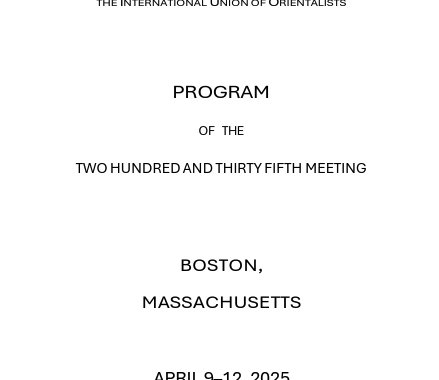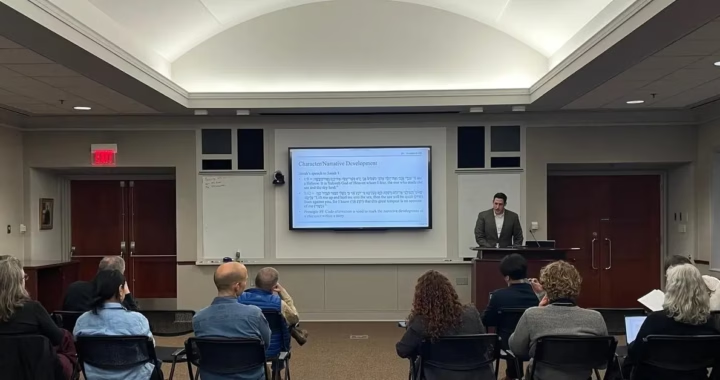M. Richey: A (Brief) Literature Review
Introduction
Madadh Richey, Assistant Professor of Hebrew Bible at Brandeis University, will be giving a department lecture at Johns Hopkins later today, April 10th, titled “Out of Egypt? Old and New Paradigms for the Origins of the Alphabet,” which is based in part on her recent article in Maarav 27, no. 1-2, titled “Syria, Mesopotamia, and the Origins of the Alphabet” (2023). In preparation for her talk, I’m reviewing some of her previous work. Specifically, I looked at her ten most recent publications and summarize them here as well as include, when available, the abstract or a relevant quote; much of her work is freely available on her academia.edu page.
Richey received her MA and PhD at the University of Chicago as well as a BA at Boston College. According to her Brandeis faculty profile, “Madadh Richey studies discourses of myth, magic, and religion within and around the Hebrew Bible and ancient Middle Eastern sources of the late second and first millennia BCE. She is engaged in literary and cultural theoretical approaches to ancient Middle Eastern material—both written and visual artistic—and pursues connections between queer theory and ancient Middle Eastern studies. Madadh is an epigrapher of Northwest Semitic inscriptions and publishes newly discovered and recently rediscovered texts in Hebrew, Ugaritic, Phoenician and Punic, and Aramaic.” Under “Selected Publications,” we read, “Madadh’s current book project, Visions of Gods and Monsters, explores religious and social functions of divine-combat images in the visual art of the Levant and Mesopotamia during the Iron Age (ca. 1175–550 BCE). Her work has appeared or is forthcoming in the Bulletin of ASOR, the Israel Exploration Journal, the Journal of Semitic Studies, and Tel Aviv, in addition to other journals and edited volumes.” Personally, I’m excited to read her new Gods and Monsters book when it becomes available, although her PhD dissertation upon which it’s based is available here and accessible here.
Richey 2023: “Syria, Mesopotamia, and the Origins of the Alphabet”
Abstract: “New potentially Early Alphabetic finds from Umm al-Marra (Syria) and Sealand (Mesopotamia) require a reanalysis of traditional out-of-Egypt hypotheses of alphabetic origins. The present article considers the problems new discoveries introduce for traditional understandings of alphabetic invention and proposes to overcome these problems by endorsing a northern Levantine context for the Early Alphabet’s initial adaptation from Egyptian hieroglyphs and its earliest usage. This proposal is contextualized among—and arguably supported by consideration of—other scribal experiments in the Levant during the Middle and Late Bronze Ages.”
Richey addresses the role that the alphabetic texts from Mesopotamia dating to the period of the First Sealand Dynasty (1730-1460 BCE) as well as four clay cylinders incised with non-cuneiform graphemes from Umm al-Marra dating to the Early Bronze III-IVB periods (2500-2200 BCE) have in potentially overhauling the regnant hypothesis that the origin of the alphabet lies in Egypt. In doing so, Richey re-centers Syria, much of which was under regular Egyptian interaction and influence, in our understanding of Bronze Age literacy. I was surprised to find out, however, that she is not the first to do this. As she admits, this view has good precedent, such as from the late, great Frank Moore Cross himself; he wrote: “recent discoveries have confirmed the view that the alphabet had its origin in an acrophonically derived, pictographic script under indirect Egyptian influence, somewhere in Syria-Palestine” (passim Richey, p. 25). Richey concurs: “it is in the northern Levantine context that the invention of the alphabet finds its most natural purposes, its most favorable conditions, and now perhaps even its earliest relics” (p. 27). Since Cross received his PhD at Johns Hopkins in 1950, it is fitting that Richey comes to lecture on the topic at his alma mater nearly 75 years later.
DeGrado and Richey 2022: “An Aramaic Ritual for Burning Straw in Sefire iA:36-37”
Abstract: “The Old Aramaic inscription Sefire I (KAI 222) includes, in a series of mimetic curses, a debated clause that has been read by most previous scholars to involve a mysterious {gnbʾ} gannābaʾ(?) ‘thief’, which (or who?) is symbolically burned (Sefire IA:36–37). The present article argues that there are lexicographic (cognates in later Aramaic dialects) and phonological (geminate prenasalization) grounds for understanding {gnbʾ} to encode instead ganbaʾ (< *gabbaʾ) ‘straw’. The burning of this straw to symbolize consequences should a treaty partner renege has clear parallels in Mesopotamian and Syro-Anatolian magical and ritual language, including treaty curses, and produces a more typical image in a list of mimetic curses involving materials (wax), objects (a bow and arrow), and animals (a calf).”
As the abstract makes clear, the authors suggest reinterpreting the Aramaic word גנבא as deriving from √gbb with secondary prenasilization which in turn denotes a fibrous product (CAL glosses “grass, hay” and “tuft of fiber”); this interpretation runs counter to the one previously assumed by all interpreters, namely that גנבא derives from √gnb ‘to steal’, i.e. gannāba’ ‘thief’. In so doing, the mimetic act is about burning straw: “just as straw is burned, may Mātiʿʾil be burned” (i.e., if he breaks the stipulations of the treatise, etc.). Later in the paper, the authors write, “A major reason that the lexical understanding adopted here is so attractive is that there is ample evidence for the use of straw and other fibrous plant material in magical texts from Mesopotamia and Syro-Anatolia” (p. 127). And again, in the conclusion, “The proposed reading of ganbaʾ ‘straw’ in place of gannābaʾ ‘thief’ permits an analysis of Sefire IA:36–37 that is consistent with the logic of other ceremonial curses and ritual actions across the ancient Middle East… The new reading thus produces a series of mimetic actions performed on materials (wax, plant fiber), objects (a bow and arrow), and a calf, all of which have precedent in the epigraphic record” (p. 133).
Vanderhooft, Richey, and Shukron 2022: “A Bulla of ʾǍdōnîyāhû, the One Who Is Over the House, from beneath Robinson’s Arch in Jerusalem”
Abstract: “The present paper publishes a new, nearly complete bulla excavated in 2013 beneath Robinson’s Arch in Jerusalem. It was first identified in 2019 during sifting of soil excavated from a Roman-era drainage channel. The bulla belonged to a Judahite government official, ‘the One Who Is Over the House’. The excavation of this bulla validates the authenticity of several other bulla bearing the same legend and clarifies both epigraphic and biblical attestations of the title ‘the One Who Is Over the House’.”
Although not reproduced in the abstract, the bulla reads: [ת]יהב על אשר // [.] ולאדניהי, ‘belonging to ʾĂdōnîyāhû // the One Who Is Over the House’. The article serves as the editio princeps of the bulla including detailed discussion of its archaeological context, epigraphy and paleography, and philological discussion of the onomastic and titulary.
Richey 2021: “The ʿAzorbaʿl Bronze Fragment from Byblos: Reading Economy and Society in Early Phoenician”
Abstract: “The present article offers a thorough re-edition of the tenth- or ninth-century BCE ʿAzorbaʿl bronze spatula inscription from Byblos (KAI 3), with attention to its epigraphic and palaeographic features, ancient use contexts, and metallic materiality. The text is interpreted as the record of a debt paid in smelted silver to ʿAzorbaʿl; this payment resolves previous economic relations between ʿAzorbaʿl and the individual on whose behalf the text was written. A newly secure epigraphic analysis is enabled by recent photographs, and the lexical analysis is supported by newly considered cognates for this inscription’s lexemes {nšbt} “smelted” and {mgšt(-)} ‘tax(es)’ in Egyptian Aramaic and biblical Hebrew, respectively.”
DeGrado and Richey 2021: “Discovering Early Syrian Magic: New Aramaic Sources for a Long-Lost Art”
Abstract: “Few magical texts have been recovered from the Levant dating to the first millennium BCE. Three recently published early Aramaic inscriptions help fill this lacuna: an inscribed cosmetic container from Zincirli, a Lamaštu amulet from the same site, and an Aramaic-inscribed Pazuzu statuette. These texts, dated paleographically to the ninth and eighth centuries BCE, afford a window onto local traditions in the Levant and their interactions with Mesopotamian magic. They also provide an impetus for a reanalysis of the infamous Arslan Tash amulets, offering further context for their texts and iconography.”
Published in Near Eastern Archaeology, I first read this article in November of last year, and it has since been one of my favorite pieces by either DeGrado or Richey. In addition to DeGrado and Richey 2022 (above) as well as both DeGrado and Richey 2019; DeGrado and Richey 2017 (not included in this lit. review), all four articles co-authored by these scholars explore the subject of Aramaic magic and ritual, a topic of great personal interest to me. In the present piece, the authors note that most magical texts known from the ancient Middle East come from either Mesopotamia and Egypt; thankfully, however, these authors are helping fill the lacuna in our knowledge of ancient (Aramaic) magic in the (Northern) Levant.
Richey 2021: “Goliath among the Giants: Monster Decapitation and Capital Display in 1 Samuel 17 and Beyond”
Abstract: “A single verse near the conclusion of 1 Samuel 17 mentions that after defeating Goliath, David took the giant’s severed head to Jerusalem (1 Sam. 17.54). The present paper argues that this text’s communicating of David’s preeminence through his act of decapitation draws on the widespread understanding of heads as uniquely powerful and vulnerable, while triumph over a giant or monstrous body casts the future Israelite king as uniquely dominant over monstrous enemies at the physical extreme. Narratives of monster-combat that center an adversary’s head and its subsequent display are widespread; the present paper discusses the Gilgamesh/Ḫumbaba and Perseus/Medusa narratives, with their corresponding visual art manifestations, to show how the biblical allusion to monstrous capital display functions socially and literarily to constitute David’s power.”
Richey 2021: “The Mesopotamian Demon Lamaštu and the Monstrosity of Gender Transgression”
This chapter in an edited volume looks at the Mesopotamian demon Lamaštu, a well-known supernatural entity from pre-Hellenistic Mesopotamia known from visual and textual sources such as dozens of amulets which included Sumerian- and Akkadian incantations in cuneiform functioning to ward her away. Richey analyzes Lamaštu’s animal monstrosity and as one who transgresses Mesopotamian gender categories.
Richey 2021: “The Media and Materiality of Southern Levantine Inscriptions: Production and Reception Contexts”
Although I do not have access to this chapter at the present time, Richey’s abstract as posted on academia is as follows: “Inscriptions from the Iron Age southern Levant were written with and on a range of media. This chapter explores several areas in which inscriptional media have important implications for biblical studies: (1) the manufacture of southern Levantine inscribed stone monuments; (2) the remains and implications of Iron Age Hebrew papyrus texts; and (3) the surprising variety of media on which texts similar to those of the Hebrew Bible are preserved.”
Richey 2020: “The Image of the Dragon in RS 16.266 (= KTU1-3 1.83): Ugaritic √ṯrp and Its Syriac, Jewish Babylonian Aramaic, and Mandaic Cognates”
Abstract: “The fragmentary Ugaritic text RS 16.266 (= KTU1–3 1.83) contains a number of lexical and other problems exacerbated by the state of the tablet and difficulties in defining the plot and characters involved in the text. One of these lexical issues involves the analysis of two verbs that appear to be from the root √ṯrp. In the present paper, I survey previous hypotheses as to the etymology and semantics of this verb and contrast the deficiencies of these with the merits of identifying a thus far unrecognized cognate set in lexemes from the root √trp in later Aramaic dialects, i.e., Syriac, Jewish Babylonian Aramaic, and Mandaic. The verbs in this cognate set have the semantics ‘to strike (esp. of a snake)’, and thus clarify both the activity and morphology of the fearsome dragon described in RS 16.266.”
After discussing the lexicographical difficulties of RS 16.266 from the perspective of later (Eastern) Aramaic cognate data, Richey proffers the following translation of ll. 4-7 of the text in question: “With (your) muzzle strike, o Yammu. With (your) tongues lick the heavens. Strike, o Yammu, with (your) tails” (p. 390).
Richey 2020: “A Figurine with a Possible Early Aramaic Inscription”
Abstract: “This article deals with an inscribed amulet in the form of an animal that was acquired by the British Museum in 1883 with the claim that its provenience was Tartus, opposite the ancient Phoenician city of Arwad. The five graphemes of the inscription, trztn, are interpreted as written in early Aramaic script, dated to the 9th or 8th centuries BCE. Most plausibly the graphemes constitute a flora-derived personal name, Tirzatan, likely that of the onetime owner of the amulet. Strengths and weaknesses of other interpretative options are also considered.”
Richey examined and photographed this previously unpublished figurine and inscription on October 26, 2016, in the British Museum (p. 237). The bronze figurine is perhaps of a donkey or mule, and its inscription reads תרזתן trztn, which she tentatively analyzes as a personal name of the pattern *qiṭlatān-, i.e. tirzatān-. This personal name presumably reflects the owner of the figurine.
Conclusion
Richey’s academia page includes 14 more publications which were outside of the scope of this brief literature review, about half of which I was previously familiar with. Not included on her academia page are at least three book reviews: (1) a 2022 review of Idan Dershowitz’s The Valediction of Moses; (2) a 2020 review of Aaron Tugendhaft’s Baal and the Politics of Poetry; and (3) a 2020 review of Laura Quick’s Deuteronomy 28 and the Aramaic Curse Tradition. Remarkably, her first publication, “The Use of Greek at Qumran,” dates back to 2012 when she was still at Boston College.
In conclusion, I, for one, am excited to meet with Dr. Richey and hear her lecture later today. I’m confident that my engagement with her work for the past few hours will make the opportunity all the more rewarding.
Update:
Lunch with Madadh went well, and the lecture was excellent. I can’t help but think that her recent Maarav article will play an important role in the future in shaping the conversation on the origins of the alphabet.
 Semester in Review: Spring 2025 at JHU
Semester in Review: Spring 2025 at JHU  235th Annual Meeting of the AOS (2025)
235th Annual Meeting of the AOS (2025)  JHU-PTS Doctoral Symposium
JHU-PTS Doctoral Symposium  Fall 2024 Semester in Review
Fall 2024 Semester in Review  DtrH: Books and Key Texts
DtrH: Books and Key Texts  Does DtrH even exist?
Does DtrH even exist?